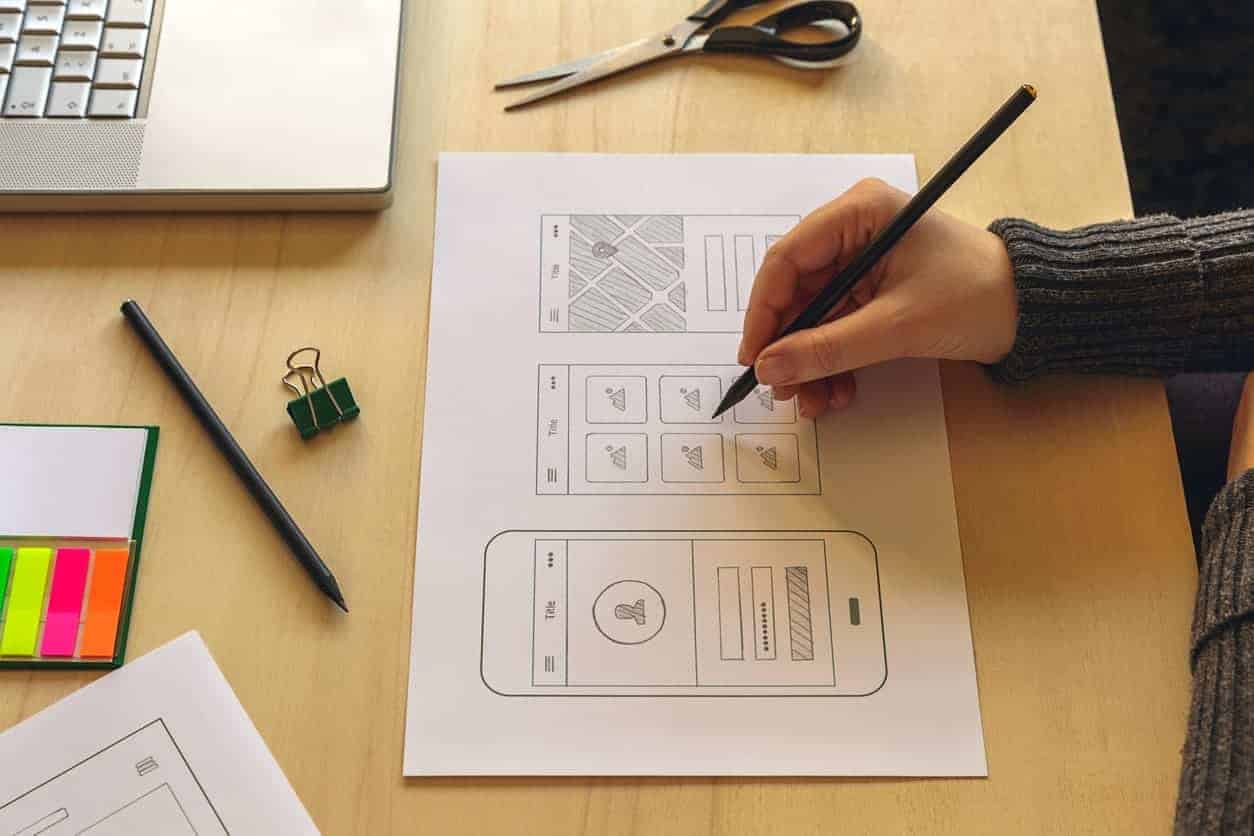Updated 10/09/24
Good web design is integral to how your business is perceived online.
Ultimately, the quality of your website influences your customers’ perception of your business. Additionally, the effectiveness of your website’s design determines how well your business ranks in search engine result pages (SERPs).
Improved search engine optimization is an important goal for businesses that want to attract more customers.
With that said many businesses don’t understand the impact of good web design on their SEO ranking.
Low-quality web design easily steers customers away and causes you to rank poorly. However, a quality web design drives more traffic, builds trust, and lays the foundation for loyal customers through an improved SEO ranking.
Therefore, we’re providing you with 5 ways good web design improves SEO rankings.
1. Clean & Intuitive Architecture
Many business owners have a hard time understanding what site architecture actually is.
Simply put, site architecture is how your website is structured and linked together.
Essentially, you want your website to be structured in a way that allows users to scroll and find information seamlessly.
Clean and intuitive architecture is essential for SEO because it helps search engines find and index your website’s pages.
Additionally, it creates link authority throughout your website.
Ultimately, it helps visitors pull the most relevant information from your website.
Implement a Filing Cabinet Architecture
This means that business owners need to ensure that their websites are consistent throughout.
Your website’s format, design, and link display should be cohesive and unified.
Formatting your website’s architecture in a filing cabinet template makes the site design intuitive and easily navigable.
Clean & Simple URL Structure
Set up your URLs so that it is obvious to users what the page is about. This will make the page content more memorable, sharable, and SEO-friendly.
“Flat” Site Architecture & Breadcrumb Linking
Additionally, businesses should refrain from having visitors go through multiple channels to find the information they need. This means that businesses that possess a “flat” site architecture have a good web design and better SEO.
A flat site architecture simply means that visitors can access any page on your website in four clicks or fewer.
Having primary category menu options in both your header and footer & available on every page will assist users in finding what they’re looking for quickly.
Implementing a breadcrumb linking structure will help achieve this goal as well.
2. Mobile Responsiveness
Mobile Optimization is Crucial

Mobile optimization is dominating the online industry. Most consumers continue to make their purchasing decisions online.
This is why it makes sense that Google focuses more attention on mobile indexing.
Google is extremely user-centric.
They understand that internet users are moving away from desktop to mobile, and businesses need to fall in line. This not only meets the needs of its customers, but Google’s search engine more easily recognizes its content.
To wit, Google has recently announced that after July 5, 2024, if your site’s content is not accessible at all with a mobile device, it will no longer be indexable.
So a mobile version of your site is a must of you want visibility!
With more consumers searching on the go, having a mobile-responsive website is important to attract more customers.
It also increases the likelihood that visitors will share your content. Google prioritizes websites that excel at meeting users’ needs. If users can’t navigate your website effectively through mobile, they will abandon your page quickly and your site’s ranking will go down as it won’t be viewed as useful.
Even more, a website not optimized for mobile use signals that your business isn’t trustworthy. It will make it more difficult for Google to determine the quality of your website.
Avoid Popups & Flash
Creating a mobile-responsive website means focusing on things such as site design and page speed.
With that said, it may be a good idea to avoid popups. It can be difficult for mobile users to close popups and will lead to a high bounce rate. In addition, it’s also best practice to avoid using flash. This is because many mobile users cannot enable flash through their mobile devices.
Page Speed Optimization is a Must
Page speed is also an important consideration for mobile users. Users want to consume information on-the-go, as quickly as possible, and without connectivity and hardware issues. This means you need to optimize images, reduce redirects, and minify code throughout your website.
3. Proper Page Formatting
Your website needs to be formatted to allow users to have a good experience as they scroll your website. Many businesses don’t pay much attention to how their website is formatted or know little about what it means to have effective formatting.
However, businesses that opt for a good web design that is simple, create the best user experience.
People naturally prefer shorter sentences, smaller paragraphs, and list structures. This kind of content is easily consumable and shareable.
Format Content Using Headings & Subheadings
To this end, it is very important to use headings and subheadings. Be sure to use these when deemed appropriate so that users understand core concepts.
This will help organize and segment your content into easily readable and digestible sections, making it easier for readers and search engines to understand it.
Utilize Whitespace
It’s also best practice for businesses to ensure that their websites include ” white space.” White space breaks up content and makes reading content more enjoyable. Focusing on these key things helps improve the user experience and increases the likelihood of content sharing.
Don’t Overwhelm Users With Too Many Links
In addition, pay attention to the number of links on your website. Too many links can overwhelm users who are trying to scan content quickly.
4. Optimized Imagery and Coding
Another key factor of good web design is optimizing your imagery and coding for a better experience.
Imagery helps draw attention and trigger emotion.
Your website coding houses important information about your website that helps it function. Unfortunately, both of these can negatively impact your SEO ranking if they aren’t optimized effectively.
Incorporate The Focus Keyword Phrase in the Alt Text
To optimize your images, you can start by naming your images descriptively and include relevant keywords. This will help your site rank better in the search engine.
In addition, optimizing your alt attributes while including the page’s focus keyword phrase, are even more important. Alt attributes are the text alternative to images when a browser is unable to render them.
Minimize Image Size
Some images can come with larger file sizes. The problem with this, though, is that it makes it more difficult for users to open up your website. Most users won’t wait for a website to load, especially if they can find information elsewhere.
Therefore, image file sizes should be decreased to increase site load speed.
One easy way to decrease file size is by saving your photos as “for the web”. To further condense the image size without compromising on image quality is to use an image compression tool. You can use sophisticated image manipulation software like Photoshop, or free online image compression tools are also available.
Code Compression & Render Blocking
When designing a site, how the site is coded and rendered plays a significant role in your page speed and overall SEO health.
Minifying JS & CSS
Most websites are coded using JavaScript and CSS.
Unfortunately, many off-the-shelf website themes have a lot of coding bloat and are not adequately compressed.
When your JavaScript and CSS are properly minified, and unnecessary code bloat is removed, your website runs much faster.
Eliminate or Defer Render Blocking Code Above the Fold
‘Above-the-fold’ content is everything that appears at the top of a visitor’s screen when they land on your website. If, when visitors land on your website for the first time, the above-the-fold content takes too long to load and appear (‘render’ in SEO speak), they will likely leave or ‘bounce’.
An increased bounce rate shows Google that your website is not a good fit for users for a particular keyword phrase. Eventually, your webpage will lose ranking, which will hurt your SEO.
Therefore, removing or deferring JavaScript and CSS code that interferes with loading above-the-fold content is critical for SEO.
This requires professional SEO expertise and know-how. Hiring a run-of-the-mill website design company that does not understand SEO or knows how to manipulate offending JS and CSS code properly will hurt your chances of outranking your competition.
5. Updated, Clean, and Intuitive Design
Good web design should provide an updated, clean, intuitive design that helps shape users’ perceptions of your business.
As per Google’s guidelines, E-E-A-T plays an important role in the ranking factor for business owners. Google is prioritizing websites that exemplify Expertise, Authoritativeness, and Trustworthiness.
Not keeping your site current can negatively impact your search engine ranking. Although the search engine is relatively sophisticated, it still has a difficult time indexing sites that aren’t current.
In addition, a website that is outdated and has a hard-to-navigate design is not perceived as trustworthy. Visitors may assume that you are not attentive to your business and that you don’t care about your customers. This will lead to visitors looking elsewhere for businesses that can meet their needs.
Oftentimes, your website is a customer’s first impression of your business. This means that it’s important for business owners to go the extra mile to design their website in a way that reflects their business and satisfies the search engine guidelines.
A clean website with few to no distracting elements makes content easy to read. Additionally, a website that is up-to-date with current design trends shows that your business is “in the know,” which customers prefer.
A clean and intuitive website makes it easier to use, meaning visitors can focus on the task at hand.
Ultimately, as a business owner, one of your main goals should be to direct your customers’ attention to what’s most important. A current website with a clean and intuitive design will help businesses achieve that.
The Bottom Line on Good Web Design
Good web design doesn’t just make a site look good; it also helps businesses improve customer experience and their SEO ranking.
As more consumers rely on the internet to interact with businesses, business owners must work diligently to improve their SEO rank to get in front of their target audience.
At LocalBizGuru, we specialize in designing optimized websites with SEO best practices in mind. Our design team works closely with the SEO team to ensure a symbiotic relationship that helps your bottom line.
If you want to design and develop an SEO-optimized website for your business, contact us today to get started.
Remember. It’s not enough to have a nice website. You need to Get Found.



